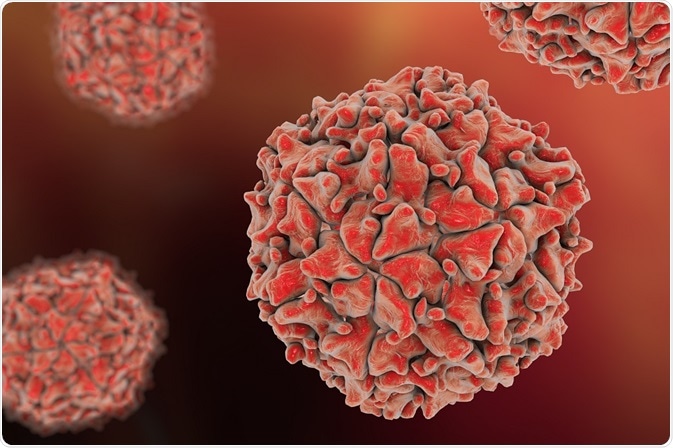Poliovirus is a member of the picornavirus family, which also includes rhinoviruses, coxsackieviruses, echoviruses, enteroviruses, and hepatitis A virus.
 Credit: Katryna Kon/Shutterstock.com
Credit: Katryna Kon/Shutterstock.com
Picornaviruses are small, about 300 angstroms in diameter, and are comprised of an icosahedral protein coat and a single-stranded positive sense RNA genome.
Poliovirus infection occurs by the fecal-oral route, when the host ingests the virus, which replicates in the alimentary tract. The virus is then shed in the feces. Most polio infections are asymptomatic. In about 5 percent of cases, the virus replicates in other tissues. Paralytic poliomyelitis occurs in less than 1 percent of cases.
Viral entry
Poliovirus infection begins with the virus binds to the receptor CD155 on the host cell surface. CD155 is an immunoglobulin-like receptor also known as poliovirus receptor. Upon binding, an irreversible conformational change occurs to the viral particle. The mechanism by which the virus enters the cell is believed to be receptor-mediated endocytosis, after which the viral RNA is released into the cellular cytoplasm.
Polio has a positive sense RNA viral genome. That means it can be directly translated into protein by the host cell. The viral proteins of poliovirus are:
- 3D(pol)--an RNA dependent RNA polymerase
- 2A(pro) 3C(pro)/3CD(pro)--proteases that cleave the viral polypeptide
- VPg (3B)--binds viral RNA and is required for synthesis of RNA
- 2BC, 2B,2C, 3AB, 3A, 3B--protein complex needed for viral replication
- VP0--cleaved into VP1 and VP3, and VP2 and VP4, the proteins of the viral capsid
Viral production
Upon release into the cytoplasm, the viral RNA is translated by the host cell machinery into a single polyprotein. The 5’ end of poliovirus is long compared to the host cell’s mRNA, about 700 nucleotides, and highly structured. That region directs translation of the viral RNA, and is known as the internal ribosome entry site.
The polyprotein is processed co-translationally by viral proteases into the viral proteins. It then undergoes myristoylation, the addition of a myristoyl group, and the N terminus of the protein chain. Viral 2A protease then cleaves the polyprotein to release a precursor protein myristoyl-P1 from the N terminus. The P1 protein contains all capsid protein sequences.
It is subsequently cleaved by viral 3CD protease into capsid proteins VP1 and VP3 and the immature capsid protein myristoyl-VP0.
Viral assembly
After translation, viral genome replication occurs, producing positive sense copies of the original genome. That process involves production of multiple negative sense copies, which are then used as templates for the positive sense strands. The protein VPg serves as a primer for both positive and negative sense strands.
At this point the proteins form a pentameric assembly intermediate, which then becomes an empty capsid with 60 copies each of VP0, VP3, and VP1. During that process, five copies each of VP1, VP3, VP1 and VP4 become the interior surface of the capsid. Each capsid is assembled with a copy of the genome inside.
Assembled polioviruses are released from the host cell through lysis of the cell, about 4 to 6 hours after infection. Each cell can release as many as 10,000 copies of the virus.
Polio Virus Life Cycle HD Animation
Further Reading
Last Updated: Feb 26, 2019